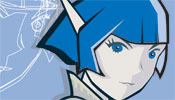
BIOGRAPHY
Associate Professor
Department of Computer Science, College of Engineering
Department of Curriculum and Instruction, College of Education
University of Illinois at Chicago
EXHIBIT
Playing Scientist, Together, Using the Whole Classroom
Thursday & Friday
This Interactive Exhibit describes the rationale for, and design, implementation, and classroom utilization of, three systems designed to support children's role playing - as scientists - in the upper elementary grades (approximately ages 10-12 years). The purpose of these systems is to engage children in authentic science practice by combining imagination with a "thin layer of computation" (Colella, Borovoy, & Resnick, 1998) as an alternative to high-fidelity imagery on personal displays. Learners are asked to imagine that scientific phenomena are unfolding in their very classrooms, invisible to the naked eye. While no (complete) rendering of the phenomena is provided, state-monitoring (either visual animations or simulated instrumentation) and control affordances are distributed around the room. The location of the affordances is meaningful; each are intended to represent a unique window into the state of the corresponding position in the imagined phenomenon. We call this class of simulation Embedded Phenomena (Moher, Hussain, Halter, & Kilb, 2005).
RoomQuake maps an earthquake range into the physical confines of a classroom. Using conventional web browsers as simulated real-time seismographs, fifth-grade students read and interpret waveforms, then use measuring tapes to effect a physical trilateration of event epicenters. In RoomBugs, horizontally oriented tablet computers serve as "sand traps" that record the paths of a variety of insects traveling across its surface; fifth students monitor populations of various species and manipulate environmental variables to control pest populations. In HelioRoom, the Sun is presumed to be situated at the center of the classroom; computers positioned along the walls of the classroom provide restricted views into the (planar) solar system, from the middle outward. Third grade students use their prior knowledge from classroom instruction along with empirical evidence (e.g., occlusion, orbital period) obtained from observation to disambiguate the identity of planets.
Embedded Phenomena are especially well suited to the elementary school classroom. Binding technologies to the environment rather than to individuals enhances both economy and reliability. The self-contained nature of elementary school "home room" (e.g., classrooms in which children receive instruction in most subjects) allows simulations to play out over weeks, allowing time for students to move from the periphery to the center of "communities of practice" (Lave & Wenger, 1990) surrounding scientific skills. The "real-time" nature of the phenomena induces a collective, continuous monitoring of the affordances for significant events in the state of the simulation. At the teacher's discretion, for example, RoomQuakes can happen during a spelling test or on the weekend; in the latter case, formal and informal learning are connected as students can use a browser at home to obtain "real-time" views of the classroom seismographs.
This interactive exhibit presents empirical data from three recent class studies employing these systems. (Two of these studies are currently in progress, and the third is scheduled for late April.) In each of these studies, we probe impact through pre-/post-unit assessments of procedural skill development, conceptual learning, and attitudes toward science learning, as well as examining audio and video protocols to track variables such as student participation rates and activity role adoptions over time and the articulation of problem-solving strategies.
Download pdf of paper
References
Colella, V., Borovoy, R., & Resnick, M. (1998). Participatory simulations:
Using computational objects to learn about dynamic systems. CHI 1998 Conference Summary, 9-10.
Lave, J., & Wenger, E. (1990). Situated learning: Legitimate peripheral
participation. Cambridge University Press.
Moher, T., Hussain, S., Halter, T., & Kilb, D. (2005). Embedding
Dynamic Phenomena within the Physical Space of an Elementary School
Classroom. ACM Conference on Human Factors in Computing Systems (CHI
2005), to appear.